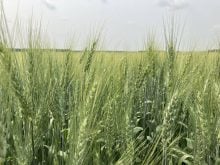REGINA – The right number of canola plants and awareness of this season’s threats will be the keys to making the most of this year’s canola crops.Due to the wide variety of conditions, producers can expect many challenges, especially if fields have distance or seeding date variances.Scouting begins with counting the populations. While this can aid in planning for the remainder of the season, it can also provide vital information about how well the seeding unit is working.Derwyn Hammond, agronomist with the Canola Council of Canada in Brandon, said producers could get the best information about their drill’s performance from a newly established crop.Improving machine settings including seed depth, packer effectiveness and seed spacing begins with evaluating an early seedling stand.”You can keep records about the seed size, weight, rate planted, weather and soil conditions, etc., when you plant. But unless you go out and verify what happened and do a plant count … you don’t get the whole picture,” he said.”You need plant stand counts.”Hammond said producers who have plant stand counts above 10 plants per sq. foot or 100 per sq. metre under average conditions can consider cutting canola seed rates.When plant survival rates fall to seven per sq. foot, that is the low end of what can result in maximum yield because there is no cushion for other weather, disease or insect problems that might occur.Hammond said if conditions have already damaged the plant stand count to below seven, then producers should be vigilant with that field.In thin crop stands, any threat should be considered as potentially doing the most harm that can be expected from that problem.”If it is an insect pest, then you need to begin treating the problem when it reaches the lowest part of the threshold range,” he said.The same applies to weeds and to diseases like sclerotinia.Weeds will advance more quickly and do more damage in stands where the canola is still working to create a canopy.Using a one-quarter metre hoop, producers can perform a count and then multiply by four to get the one metre count.Several counts should be made across a field to ensure that the data is consistent for the field. Other parts of the field may be considerably higher or lower and paint a different crop prospect picture.While scouting plant populations, farmers should look for the first pest threats after early season flea beetles.Across the Prairies, producers are seeing cutworm damage at levels that meet the spraying thresholds and there has been a resurgence of flea beetles in late seeded crops. Agronomists say producers should consider looking for apothecia mushrooms in areas where sclerotinia is a known pest.
Read Also

Why feds imposed EV tariffs
Moe and Kinew have a fight on their hands when it comes to eliminating the EV tariff. Canada has to worry about pissing off the U.S. and Mexico and hundreds of thousands of auto workers.














